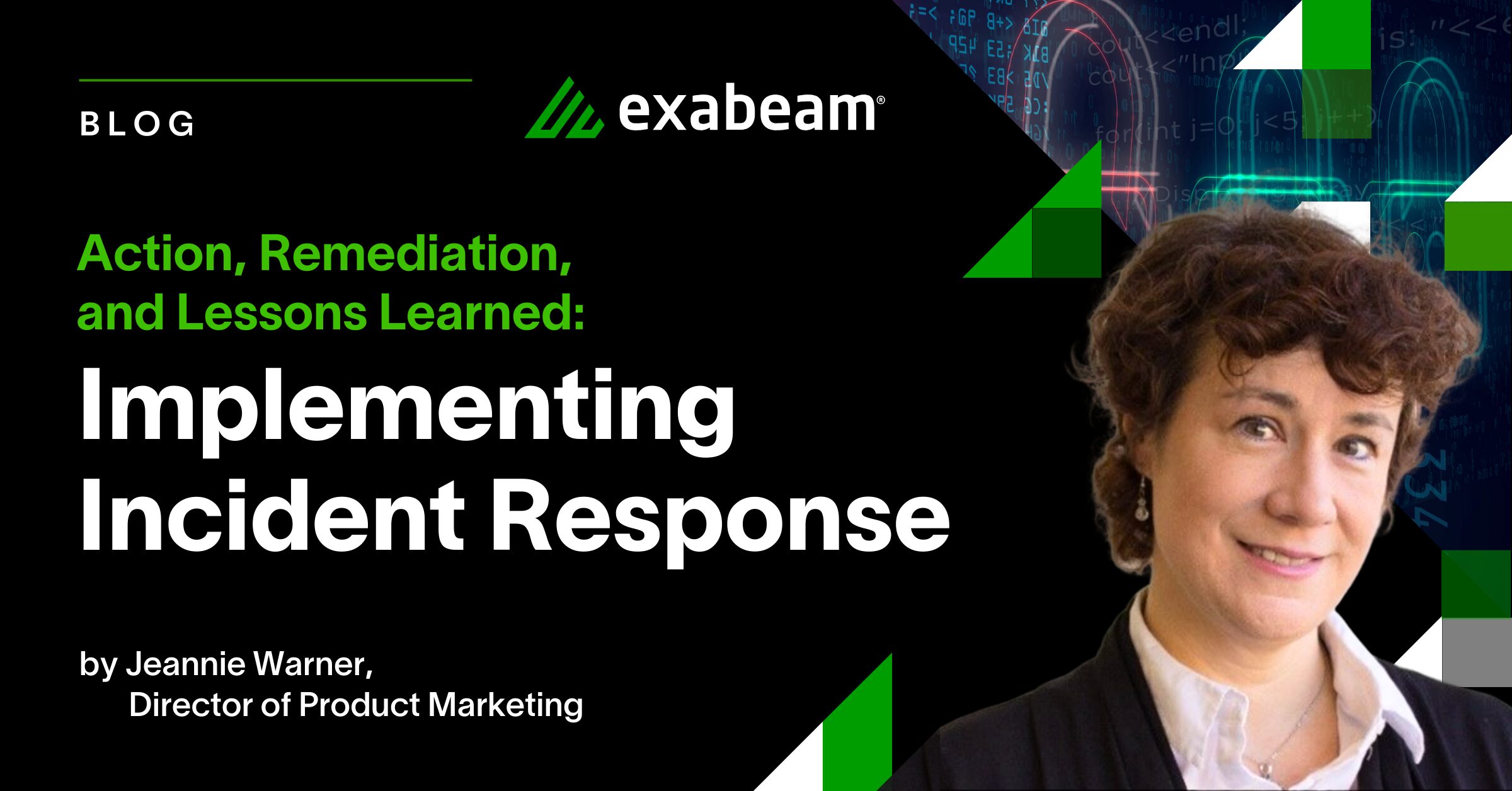Are Systems Integrators Pricey? Not If You Consider How They Reduce Costs Long Term

As a security executive, you are inundated with a daily onslaught of risks and threats to your organization amidst layoffs, organizational budget cuts, geopolitical challenges, and a general shortage of cybersecurity resources. The best technology is critical for addressing these challenges, but perhaps just as importantly, organizations should leverage trusted advisors to help prepare for when something happens, and to avoid hidden costs to the organization in the future.
In this article:
- Who are these trusted advisors?
- Why this is important for an insider threat program
- Consider the price tag: What we typically consider
- Consider the price tag: What we should also consider
Who are these trusted advisors?
You probably already work with them. Think of Systems Integrators (SIs) as problem solvers who not only deploy Exabeam technology, but do so with considerations on:
- People who manage, operate, and use the technology. Think about your engineer and SOC manager as well as cross-functional executives who consume the technology’s output.
- Processes needed for the technology to be successfully leveraged within the organization and avoid becoming shelfware. This includes engineering and security operations processes, and also, related processes such as HR, audit, identity, executive reporting, and others.
- And other technologies which must be integrated so the organization gets what it wants out of the investments which have been made. Consider other systems which feed the security information and event management (SIEM) or user and entity behavior analytics (UEBA), such as privileged access management, data leakage, ticketing systems, and others which make for a holistically functioning system.
Many of these Trusted Advisors may already be engaged in helping to execute board mandated “Big Rock” initiatives such as business transformation (e.g., cloud transformation), zero trust initiatives (e.g., authentication and authorization), or even standing up your insider threat program.
Why this is important for an insider threat program
Being dedicated to learning about YOU
The Verizon 2022 Data Breach Investigations Report noted that 82% of this year’s incidents and breaches involved the human element. Exabeam provides leading Next-gen SIEM and security analytics to find those malicious users hiding in plain sight. But as we all know, people are different. Getting beyond the generic categorization of insider threats, what specific ways do people (e.g., employees, contractors, temps) pose malicious or inadvertent risks to your organization? With the support of Systems Integrators you can perform the analysis up front and tailor your technical deployment to your company’s specific risks, threats, geographic considerations, and organizational culture.
Bringing a broad range of expertise
Instead of staffing with a single resource, engaging System Integrators is like bringing on an army of experts in a single swoop. They often provide valuable access to resources and tools, key “gotchas”, and lessons learned. Other benefits include support to ensure security investments help yield a return on investment by aligning cross-functional stakeholders across your organization. They bring in knowledge collected from dozens of global implementations, with the benefit of doing this across multiple industries. This knowledge can help identify new threats not previously considered as organizations further automate and digitize processes. For example, take key learnings that manufacturing companies, as they combine operational technology (OT) with information technology (IT), can glean from financial services companies who have relied on digitization of their business assets for arguably far longer. With this knowledge, they can help organizations gain efficiencies.
Elevating the conversation
Digitization of most parts of a company’s business means that technology infrastructures are interconnected, migrated to the cloud, accessible by remote workers, and mission-critical to businesses with nonexistent physical borders. As a result, security increasingly becomes a board-level conversation. Arming an executive with the right information that speaks to risks posed to a company’s business strategy becomes critical. With Exabeam, an organization can detect malicious users, unauthorized access to — or theft of — intellectual property (IP), and suspicious lateral movement.
Consider the price tag: What we typically consider
The role of the Trusted Advisor goes beyond data configuration and tuning by elevating the conversation to business value. For example, the detection of lateral movement may signal a malicious insider. It can also indicate weaknesses in the organization’s security controls, which could have a negative downstream impact when the organization must prove it took all necessary measures to protect consumers in the event of a data breach. There is further possible economic impact to the organization if this data includes intellectual property (IP) stolen by a nation-state threat and put into the hands of a foreign competitor (think APT-10).
There are tangible costs and benefits to consider when assessing new technology and consulting services. Most notably, a security breach’s financial impact is costly and devastating to both large and small enterprises. A recent CISA Insider Threat Mitigation Guide reported that for companies with 500 employees or less, the total annualized cost of an insider breach is $7.7M. In comparison for companies larger than 17K employees, this figure is $16.7M. And by 2025, Cyber Security Ventures estimates that the global cost of cybercrime will be $10.5 trillion.
Other intangible costs include reputational risk, consumer and brand trust, and loss of market share if a competitor exploits ill-gained IP. And consider the intangible cost to employees; this is an environment where your employees are both an asset and a risk. The reported cybersecurity attrition rate is at 20% in a market where the U.S. Bureau of Labor and Statistics estimates there will be 3.5 million cybersecurity job openings in the next few years. These statistics highlight the importance of monitoring external threats and insider risks, such as disgruntled employees. External consulting resources help with monitoring potential insider threats while easing staff workloads and potential burnout. Moreover, there is the benefit of disseminating knowledge across multiple resources instead of a single employee within your organization.
Despite these tangible and intangible costs, organizational budgets are shrinking overall (even if allocations to security are up 5%), and the ability to do more with less is even more critical. This is especially true when considering that cybersecurity is a journey with an ever-changing destination. So how can an organization further demonstrate the need to invest in technology and consultants?
Consider the price tag: What we should also consider
Navigating global compliance matters
The Exabeam Security Operations Platform comes with predefined compliance reports that simplify the workload on organizations battling both external and internal threats. By partnering with System Integrators, customers benefit from simplified reporting and a team of experts ready to address the latest regulator requirements. As a result, the technical deployment not only adheres to local and global requirements — things such as data masking, segregation of duties of access, etc.— but also that the output from Exabeam can be effectively leveraged to streamline and automate compliance efforts. Identifying manual control processes and automating them frees up resource time on things that will yield more value to the business.
Demonstrating level of preparedness
With Exabeam, Security Executives get increased visibility over users and assets, and the overall risk landscape. Through Exabeam SIEM, organizations can also measure their security control environment’s effectiveness, or lack thereof, by seeing trends across threats and incidents. In the event of a breach, a System Integrator can compile this information and support the organization in demonstrating that they took reasonable steps to protect a consumer.
Systems Integrators can also help the security executive prepare an organization in the event of a breach. One typical example is taking Exabeam output and developing playbooks for incident response workflows spanning cross-functionally. But Systems Integrators can also run these cross-functional teams through tabletop exercises to identify process gaps and areas that need further efficiencies. This is best done now and not in the face of an incident or breach.
Risk reduction, risk mitigation, risk transference
Finally, many organizations hire Systems Integrators with the expectation that at least some of their risk will be reduced, mitigated, or transferred. Especially Big 4 consulting firms, their work is scrutinized by public entities. In the face of an incident or breach, the organization is not in it alone. They have the backing and support of a global firm behind them.
You don’t have to go it alone
Increasingly security executives are asked to do more with limited resources. At the same time, threats continue to grow in complexity due to the geopolitical and economic landscape. Demonstrating that your security monitoring program, and strategic programs like Insider Threats, are reducing risks to your business is crucial.
While justifying up-front costs for both technology and outsourced consulting services might seem daunting, consider that the investment can qualify the return on investment in tangible and intangible ways:
- Speed and peace of mind of standing up an insider threat program with experts who have done this before
- Support of resources trained across technologies as well as process best practices
- Value of having a brand-name firm to identify ways to identify, address, and mitigate risks before they become a cost to the organization
- The ability to demonstrate due diligence — that you’ve done everything to avoid being in the news and hiding security incidents, as some security chiefs have recently
At the end of the day, as we go along this journey, it’s best not to do it alone.
To find out more about the Global Systems Integrators accredited to deploy Exabeam, please reach out to [email protected].
How to Build an Insider Threat Program with Exabeam
Sometimes even having a SOC isn’t enough to address insider threats. Security operations teams are managing massive amounts of data across billions of events from on-premises and the cloud, but looking for specific needles like insider threats has special requirements that encompass both searching historic data and seeing evolving credential behavior changes as they happen.
Whether from downsizing or expanding business, employees, vendors, contractors and others are moving in and out of your environment. And often, it is during these turbulent times that insider threats go unobserved — because everything is changing.
In this webinar, you will learn about:
- The four common scenarios where you need an insider threat team, and how to build a mission statement and tools
- Four attributes of a successful insider threat program
- How behavioral analytics baselines “normal” behavior of users and devices — showing risk faster
- Automated investigation experience that automates manual routines and guides new insider threat teams

Similar Posts
Recent Posts
Stay Informed
Subscribe today and we'll send our latest blog posts right to your inbox, so you can stay ahead of the cybercriminals and defend your organization.
See a world-class SIEM solution in action
Most reported breaches involved lost or stolen credentials. How can you keep pace?
Exabeam delivers SOC teams industry-leading analytics, patented anomaly detection, and Smart Timelines to help teams pinpoint the actions that lead to exploits.
Whether you need a SIEM replacement, a legacy SIEM modernization with XDR, Exabeam offers advanced, modular, and cloud-delivered TDIR.
Get a demo today!










